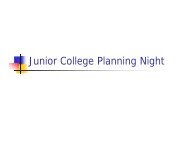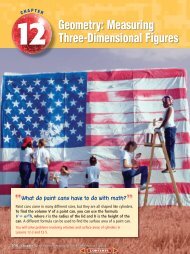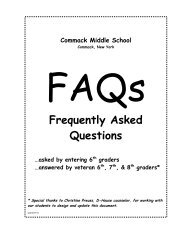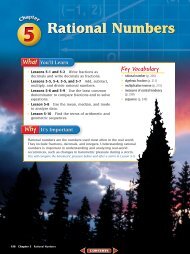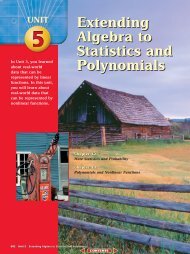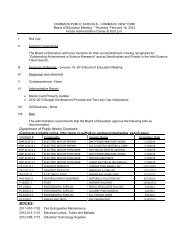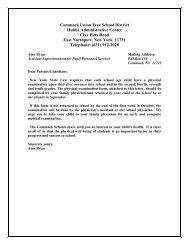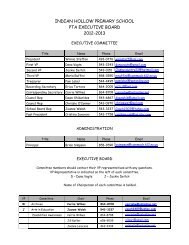Preparing for the Regents Examination Geometry, AK
Preparing for the Regents Examination Geometry, AK
Preparing for the Regents Examination Geometry, AK
Create successful ePaper yourself
Turn your PDF publications into a flip-book with our unique Google optimized e-Paper software.
5 1. −−<br />
FG is <strong>the</strong> perpendicular bisector of −−<br />
HI .<br />
2. −−<br />
JG is <strong>the</strong> perpendicular bisector of −−<br />
HI .<br />
(F, J, and G are collinear.)<br />
3. −−<br />
HJ −<br />
IJ<br />
4. −−<br />
GJ −−<br />
GJ<br />
5. HJG and IJG are right angles.<br />
(Definition of perpendicular bisector)<br />
6. HJG IJG (Right angles are<br />
congruent.)<br />
7. HGJ IGJ (SAS SAS)<br />
8. 1 2 (Corresponding parts of<br />
congruent triangles are congruent.)<br />
6 1. −−<br />
AB and −−−<br />
CD bisect each o<strong>the</strong>r.<br />
2. −−<br />
AB −−−<br />
CD<br />
3. −−<br />
AC −−−<br />
AD<br />
4. −−<br />
BC −−<br />
BD<br />
5. −−−<br />
AD −−<br />
BD<br />
6. −−<br />
AC −−<br />
BC<br />
7. ACBD is an equilateral quadrilateral.<br />
(Definition of equilateral quadrilateral)<br />
7 1. 1 2<br />
2. 3 4<br />
3. −−<br />
XZ −−<br />
XZ<br />
4. XVZ XWZ (ASA ASA)<br />
5. −−−<br />
XV −−−<br />
XW (Corresponding parts<br />
of congruent triangles<br />
are congruent.)<br />
6. XV XW<br />
7. −−−<br />
XZY ; −−−−<br />
VYW<br />
8. −−<br />
XY is <strong>the</strong> perpendicular bisector of −−−−<br />
VYW .<br />
(A point equidistant from <strong>the</strong> endpoints<br />
of a line segment is on <strong>the</strong> perpendicular<br />
bisector of <strong>the</strong> line segment.)<br />
8 BP CP<br />
4 y 4<br />
y 1<br />
AP CP<br />
x y 4<br />
x 1 4<br />
x 5<br />
9 AP BP<br />
3x y x y<br />
x y<br />
BP CP<br />
x y 4<br />
x x 4<br />
x 2<br />
y 2<br />
10 CG AG 10<br />
24 Chapter 5: Congruence Based on Triangles<br />
5-7 Constructions<br />
(page 83)<br />
1 (4) BAC and GHI<br />
2 A B C<br />
3<br />
4<br />
5<br />
S<br />
A B<br />
V<br />
E F<br />
T<br />
C D<br />
R<br />
1 2<br />
3<br />
6 If <strong>the</strong> legs of <strong>the</strong> compass <strong>for</strong>m two sides of<br />
a triangle, <strong>the</strong>n <strong>the</strong> line segment connecting<br />
<strong>the</strong> pencil to <strong>the</strong> point is <strong>the</strong> third side. If<br />
<strong>the</strong> angle between <strong>the</strong> legs does not change<br />
(and <strong>the</strong> legs remain <strong>the</strong> same length), <strong>the</strong>n<br />
any line segment connecting <strong>the</strong> legs is<br />
congruent to <strong>the</strong> original because of SAS<br />
congruence.<br />
7<br />
A<br />
G<br />
F<br />
B<br />
E<br />
H C<br />
D L<br />
The first arc drawn in <strong>the</strong> construction creates<br />
an isosceles triangle, BGH. The rest of<br />
<strong>the</strong> construction copies <strong>the</strong> sides of BGH to<br />
a new triangle. ED BH, FD GH, and<br />
FE GB, since F and G lie on <strong>the</strong> intersections.<br />
There<strong>for</strong>e, BGH EFD by SSS<br />
congruence and all corresponding angle<br />
measures, including B and E, are equal.




